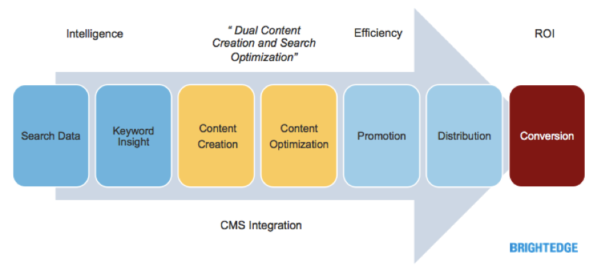Content & SEO Alignment: 3 Steps To Create The Perfect Win-Win
According to new research, brands invest $44 billion in content every year. As online content marketing budgets rise, it is essential that modern day marketers align their content and SEO efforts to maximize ROI. Have you ever been in a situation where: You create some killer content, but no one finds it online? Your SERP […]
According to new research, brands invest $44 billion in content every year. As online content marketing budgets rise, it is essential that modern day marketers align their content and SEO efforts to maximize ROI.
Have you ever been in a situation where:
- You create some killer content, but no one finds it online?
- Your SERP position slides as Google thinks your content sucks?
- Your technical SEO is awesome, but techs do not understand the human and behavioral element to content production?
Left Brain Meets Right Brain
For many organizations, SEOs and content marketers have long occupied distinct and separate spheres, often fighting with each other over the implementation of SEO changes, templates, tags and timings on site releases.
Many content marketers lacked the knowledge to implement SEO best practices and, similarly, many SEOs were not well versed in the importance of quality content. (Remember the good old days of keyword stuffing?)
These two types are marketers are driven by two different sides (hemispheres) of the brain. Left-brain marketers (the traditional SEOs) tend to be analytical and numbers-driven in nature. Right-brained marketers (the traditional content marketer) are more open to creative concepts and imaginative storytelling.
Yet, with the fusion of media comes a fusion of minds. The modern-day marketer balances left- and right-brain thinking. They use SEO and technology as an enabler and distributor, using content marketing creativity to build holistic content and SEO programs that result in measurable business outcomes.

Infographic from Marketo. (Click to enlarge.)
Convergence Yet Divergence
A positive outcome of Google’s seismic shift toward content is that we now live in a world where SEO and content marketing efforts align. Unfortunately, this is not necessarily reflected in how organizations and departments work.
It’s an unfortunate catch 22: SEO and content strategies need to be aligned for optimal marketing performance, yet the costs and time associated with training and development can negatively impact productivity, scale and revenue. This catch 22 makes it difficult to achieve such levels of collaboration, and divergence remains.
In a post Panda and Penguin SEO environment, the relationship between content writers, publishers and SEOs needs to be based on synergy and “whole brain” strategies.
To restore equilibrium, the content team should be asking the SEO team, “How can you ensure my content performs?” The SEO team should be asking, “What can I do to help you optimize your content before publishing?”
Content Management & SEO
The rapid growth and evolution of content marketing has meant that content is now being created, consumed and shared at massive scale. With scale comes the challenge of measurement and alignment with business outcomes. Concurrently, SEO has evolved to become one of the largest, most efficient and most measurable marketing channels.
According to the yet-to-be-released BrightEdge 2014 Search Marketers survey across a customer base of 8500 brands, over 83% of marketers are placing a greater strategic importance on content performance by optimizing for organic search.
Optimizing content for search engines not only generates revenue rapidly, it also helps identify the best performing content for promotion across all digital channels. This includes paid search, email, display, social, video and mobile.
The Role Of The Content Management System
Content management systems have now evolved to help bridge the gap between SEO, content and technology. The effective use of a CMS forms the backbone of my 3-step framework to drive content and SEO ROI. Technology, in this instance, is used as a key enabler to fuse together the content and search optimization process.
A 3-Step Content & SEO Framework To Drive ROI
- Empower Authors To Create What Matters To The User. SEO is the best channel to help content marketers understand demand. Utilize search data to identify what topics matter to the consumer and empower content writers with these insights at the time of authoring.
- Enable Teams To Distribute Content Effectively. Have content teams work closely with search and social teams to help distribute content. Ensure that you pair content on pages with SEO keywords and constantly optimize pages based on competing keyword terms. This is where you can really integrate SEO into your content production process.
- Track & Improve Content Performance. Track content performance at a page level and assess how well content is performing through organic search.
The Win-Win
Optimizing content for search at the time of authorship has a massive impact on the value of your content while, at the same time, increasing productivity and efficiency of the SEO and content teams. This is in addition to the most important wins: greater outcomes for your business and a better experience for your visitors.
On Wednesday, March 26, (2 p.m.) at the Adobe Summit, I will be sharing deep insights into the latest BrightEdge innovation Content Optimizer technology for Adobe Experience Manager.
This is when the statistics really do the speaking!
Contributing authors are invited to create content for Search Engine Land and are chosen for their expertise and contribution to the search community. Our contributors work under the oversight of the editorial staff and contributions are checked for quality and relevance to our readers. The opinions they express are their own.
Related stories

